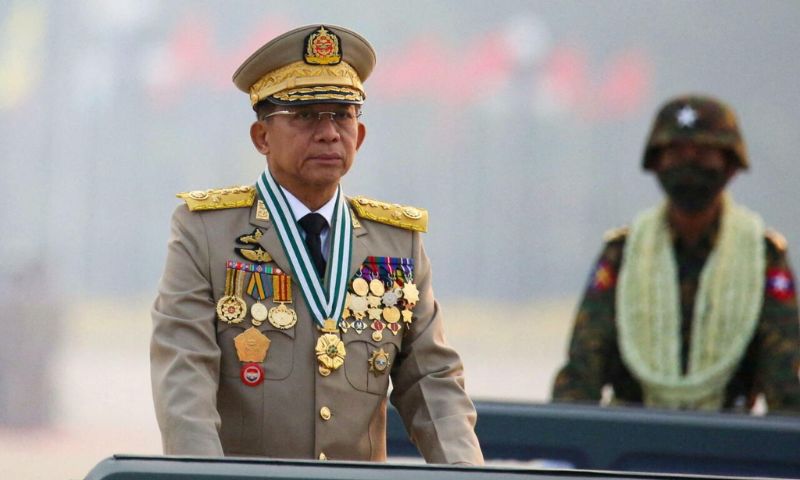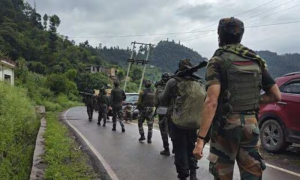SHAN, Myanmar: In a significant escalation of hostilities in Myanmar, an alliance of ethnic minority groups has seized towns and blocked trade routes to China, marking one of the most extensive coordinated offensives against the military since the coup in 2021.
This latest wave of violence has been unfolding over the past week, predominantly in northern Shan state, leading to the displacement of over 23,000 people, as reported by the United Nations. The conflict is being described as the most severe military challenge to the junta since its seizure of power.
The alliance responsible for these actions comprises the Myanmar National Democratic Alliance Army (MNDAA), the Ta’ang National Liberation Army (TNLA), and the Arakan Army (AA). On Thursday, they announced the capture of numerous military outposts, four towns, and the strategic blockage of vital trade routes to China. This move has significantly disrupted the flow of goods and resources to one of Myanmar’s most significant neighbors and trading partners.
In response to these developments, Min Aung Hlaing, Myanmar’s junta chief, has issued a clear and stern warning, stating that the government will launch counter-attacks against the armed groups. Furthermore, he accused the Kachin Independence Army (KIA), which operates in the neighboring Kachin state, of attacking “transport facilities” and military bases. Min Aung Hlaing made it explicitly clear that the military would retaliate against these actions.
The situation on the ground has become increasingly chaotic and unpredictable. In a major setback for the junta, it was revealed that they had lost control of Chinshwehaw town, a significant trade hub located on the border with China’s Yunnan province. This loss underscores the effectiveness and determination of the ethnic minority groups in challenging the junta’s authority.
Residents of Hsenwi, a strategic transport node situated approximately 90 kilometers from Chinshwehaw, have found themselves in the midst of ongoing clashes. One resident described the situation as chaotic, with neither the military nor the alliance groups maintaining control over the town. The region has been witnessing daily fighting, including heavy artillery shelling and airstrikes. In a significant development, a vital bridge has been damaged, effectively dividing the town into two parts. People from outlying villages are seeking refuge in the town to escape clashes in the surrounding countryside.
The ongoing fighting has taken a toll on the local population, with reports indicating casualties among civilians. Tragically, ten civilians have been killed, and another ten have been wounded in the crossfire. Access to the remote region remains challenging, making it difficult to confirm the exact casualty toll and provide immediate assistance to those affected.
Local residents have demonstrated incredible resilience and resourcefulness amid these challenging circumstances. With the town divided and communication severely disrupted, they have resorted to sharing available resources, ensuring that everyone has enough to eat. This community support has become essential as thousands of people find themselves stranded in the town.
The crisis has not gone unnoticed by Myanmar’s neighbors. Thailand has put in place plans to evacuate 162 of its citizens from Laukkai, a town situated approximately 35 kilometers from Chinshwehaw. The ethnic armed groups have hinted that Laukkai could be their next objective. This comes in the wake of ongoing fighting in Laukkai, a key center in a region known for illicit activities, including drug trafficking, gun-running, prostitution, and online scam operations. The town has witnessed multiple rounds of clashes between the military and various armed groups in the past.
China has also weighed in on the situation, urging an “immediate” ceasefire in Shan state. This region is of great significance to China, particularly in the context of its Belt and Road infrastructure project, which includes a planned billion-dollar rail link. The disruption caused by the ongoing conflict poses significant challenges to this ambitious project.
Myanmar’s borderlands have long been home to a myriad of ethnic armed groups, some of which have been engaged in conflicts with the military for decades, primarily revolving around autonomy and control of valuable resources. In the aftermath of the 2021 coup and the military’s violent crackdown on dissent, some of these groups have played a role in training and equipping newly formed “People’s Defense Forces.”
The armed groups involved in the recent offensive, including the AA, MNDAA, and TNLA, have claimed that the military has suffered substantial losses since the conflict began last Friday. However, verifying casualty numbers remains challenging due to the region’s remote and rugged terrain, combined with limited access and communication.
As the situation continues to evolve, international concern is growing, and calls for an immediate ceasefire have been made. The ongoing conflict has once again highlighted the complex and multifaceted challenges facing Myanmar and its people.
In this turbulent environment, the safety and well-being of civilians remain a top priority, and efforts to provide humanitarian assistance are imperative. While the situation is fluid and ever-changing, the resilience and resourcefulness of local communities and the determination of various armed groups continue to shape the course of events in Myanmar’s northern regions.






















